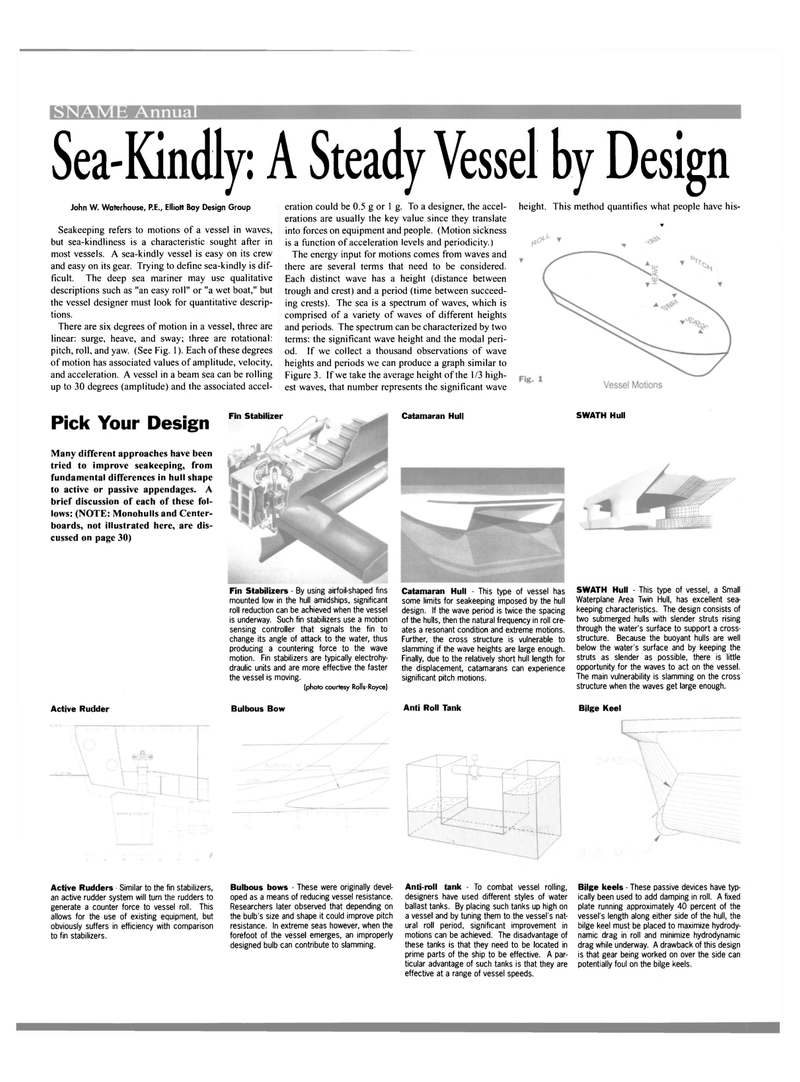
Page 26: of Maritime Reporter Magazine (October 2001)
Read this page in Pdf, Flash or Html5 edition of October 2001 Maritime Reporter Magazine
Sea-Kindly: A Steady Vessel by Design
John W. Waterhouse, P.E., Elliott Bay Design Group
Seakeeping refers to motions of a vessel in waves, but sea-kindliness is a characteristic sought after in most vessels. A sea-kindly vessel is easy on its crew and easy on its gear. Trying to define sea-kindly is dif- ficult. The deep sea mariner may use qualitative descriptions such as "an easy roll" or "a wet boat," but the vessel designer must look for quantitative descrip- tions.
There are six degrees of motion in a vessel, three are linear: surge, heave, and sway; three are rotational: pitch, roll, and yaw. (See Fig. 1). Each of these degrees of motion has associated values of amplitude, velocity, and acceleration. A vessel in a beam sea can be rolling up to 30 degrees (amplitude) and the associated accel- eration could be 0.5 g or 1 g. To a designer, the accel- erations are usually the key value since they translate into forces on equipment and people. (Motion sickness is a function of acceleration levels and periodicity.)
The energy input for motions comes from waves and there are several terms that need to be considered.
Each distinct wave has a height (distance between trough and crest) and a period (time between succeed- ing crests). The sea is a spectrum of waves, which is comprised of a variety of waves of different heights and periods. The spectrum can be characterized by two terms: the significant wave height and the modal peri- od. If we collect a thousand observations of wave heights and periods we can produce a graph similar to
Figure 3. If we take the average height of the 1/3 high- est waves, that number represents the significant wave height. This method quantifies what people have his- •
Catamaran Hull
Catamaran Hull - This type of vessel has some limits for seakeeping imposed by the hull design. If the wave period is twice the spacing of the hulls, then the natural frequency in roll cre- ates a resonant condition and extreme motions.
Further, the cross structure is vulnerable to slamming if the wave heights are large enough.
Finally, due to the relatively short hull length for the displacement, catamarans can experience significant pitch motions.
Anti Roll Tank
SWATH Hull
SWATH Hull - This type of vessel, a Small
Waterplane Area Twin Hull, has excellent sea- keeping characteristics. The design consists of two submerged hulls with slender struts rising through the water's surface to support a cross- structure. Because the buoyant hulls are well below the water's surface and by keeping the struts as slender as possible, there is little opportunity for the waves to act on the vessel.
The main vulnerability is slamming on the cross structure when the waves get large enough.
Bilge Keel
Pick Your Design Fin Stabilizer
Many different approaches have been tried to improve seakeeping, from fundamental differences in hull shape to active or passive appendages. A brief discussion of each of these fol- lows: (NOTE: Monohulls and Center- boards, not illustrated here, are dis- cussed on page 30)
Active Rudder
Fin Stabilizers - By using airfoil-shaped fins mounted low in the hull amidships, significant roll reduction can be achieved when the vessel is underway. Such fin stabilizers use a motion sensing controller that signals the fin to change its angle of attack to the water, thus producing a countering force to the wave motion. Fin stabilizers are typically electrohy- draulic units and are more effective the faster the vessel is moving. (photo courtesy Rolls-Royce)
Bulbous Bow
Active Rudders - Similar to the fin stabilizers, an active rudder system will turn the rudders to generate a counter force to vessel roll. This allows for the use of existing equipment, but obviously suffers in efficiency with comparison to fin stabilizers.
Bulbous bows - These were originally devel- oped as a means of reducing vessel resistance.
Researchers later observed that depending on the bulb's size and shape it could improve pitch resistance. In extreme seas however, when the forefoot of the vessel emerges, an improperly designed bulb can contribute to slamming.
Anti-roll tank - To combat vessel rolling, designers have used different styles of water ballast tanks. By placing such tanks up high on a vessel and by tuning them to the vessel's nat- ural roll period, significant improvement in motions can be achieved. The disadvantage of these tanks is that they need to be located in prime parts of the ship to be effective. A par- ticular advantage of such tanks is that they are effective at a range of vessel speeds.
Bilge keels - These passive devices have typ- ically been used to add damping in roll. A fixed plate running approximately 40 percent of the vessel's length along either side of the hull, the bilge keel must be placed to maximize hydrody- namic drag in roll and minimize hydrodynamic drag while underway. A drawback of this design is that gear being worked on over the side can potentially foul on the bilge keels.

 25
25

 27
27
